Last updated: 30 September 2004
|
Last updated: 30 September 2004 |
This page documents the Meade Lunar Planetary Imager comments, tips, and photos. Contributions welcome. I have posted a review of using the Autostar Suite and LPI on the Macintosh. In order to showcase the LPI you may occasionally see images taken with other telescopes on this page.
Subject: Autostar Suite LPI problem Sent: Wednesday, September 29, 2004 06:20:19 From: Menefee, Scott (Scott_Menefee@baylor.edu) I got an LXD75 N-6 yesterday that came with the Autostar Suite, and shortly thereafter ran across your web site, from which I am already benefiting considerably. I have yet to get the LPI to work at all. My computer recognizes the hardware, the red light comes on the LPI, and I get no error messages at all, but I never get anything on the live view but a black screen (and yes, the lens cap is off). If you have any ideas or suggestions, given your familiarity and expertise with the product, I would greatly appreciate it. Thanks, ScottMike here: The LPI requires some pretty significant CPU horsepower. If your computer is slower than about 500MHz then you will likely have problems.
And:
It's a 1.6g cpu with a gig of ram.Mike here: Well, CPU isn't the problem. When you point the LPI at a light in the house do you see any light at all on the screen?
Subject: Meade LPI: Small Telescopes Sent: Thursday, September 23, 2004 05:41:55 From: Graham, John L (Graham@udri.udayton.edu) We've had great weather here for almost a week and I was ready for a break from dragging out my homebuilt 16.5", so last night I got out one of my little 60mm f/12 refractors. The Moon looked great and I was curious to see how well the Meade LPI would work with it. The attached picture is a composite of three images (one each for the poles and the equatorial region of the Moon) taken with the LPI at the prime focus. Each source image was an average of 50 frames with medium edge sharpening real-time using the LPI software. I've also been getting some great pictures through a microscope using the LPI, but I figure that's for another forum. Have a great day, -John
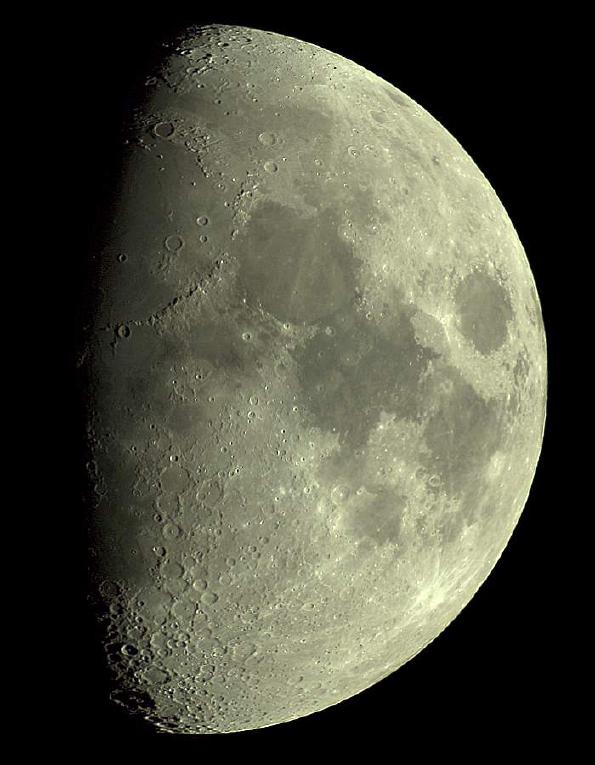
Subject: LPI freezes when stop button pressed Sent: Sunday, September 19, 2004 22:59:52 From: Gerald Sargent (sargentg@bigpond.net.au) Using LPI on a Toshiba 4280 with 500MHz CPU and 256K of RAMand 40G HD. It seems to record images (onto HD), and to present them as images in some undetermined mode. However there are no boxes appearing in the bottom left recording progress, and when the STOP buttom is pressed the computer freezes and one has then to reboot the system. I have much other software (Sky6, MiraPro, DeskTop Universe etc) on this Laptop and have not experienced any hassels with any of these. I am aware that others find the LPI useful, and have seen it used on other Laptops. This problem occurs when nothing else is being run on the computer, which uses a fully updated Win98SE o/s with ie ver 6 and Direct X (latest version). Any advice gratefully receivedMike here: The LPI requires a lot of processing horsepower. It could be that the computer you are using just doesn't quite make it.
And:
Many thanks, very difficult to get answers re LPI from anywhere, thanks Gerald.
Subject: Meade LPI: Saturn Sent: Monday, September 13, 2004 07:40:52 From: Graham, John L (Graham@udri.udayton.edu) I was dying of curiosity as to how well the LPI would work with Saturn using my little 5.1" f/8 Meade DS-2130 and I had an opportunity this past Saturday morning (September 11, 2004). As the attached photo shows it worked pretty well. This image is a composite of 5 source images combined using Registax. The source images themselves were each about 60 frames averaged live using the LPI software. Not bad for a small Newtonian telescope. -John
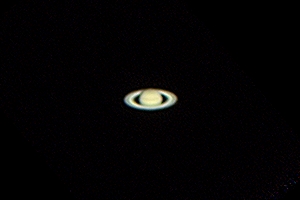
Subject: LPI Images Sent: Monday, September 6, 2004 08:53:01 From: Richard Shoesmith (r_shoesmith@madasafish.com) Please find attached two images obtained using the LPI with ETX105. The moon image is a composite of two, stitched together using PaintShop Pro. All the images were obtained using the Moon setting for the LPI, dark spot auto-tracking and align & combine. Each is a combination of 25 images.Mike here: I don't know if the Autostar Suite software is doing that.One question. I read on your site that the latest firmware release for the #497 will swap between sidereal and lunar tracking. Does the same thing happen if using the Autostar Suite to control the scope? Best wishes, Richard Shoesmith Orkney, UK 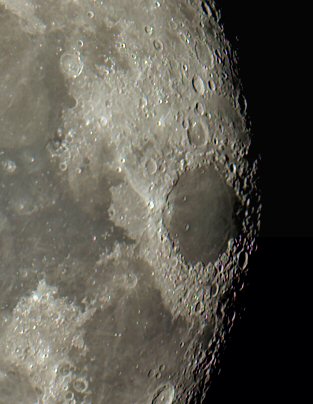
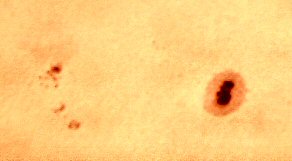
Subject: LPI Alive & Well! Sent: Thursday, August 26, 2004 03:30:02 From: Steven S. Miller (steven.s.miller@worldnet.att.net) Turns out my Meade LPI is alive and well after all. The problem was indeed my old Compaq 333 mhz laptop. Got a new Toshiba 2.8 ghz notebook a couple of weeks ago (Best Buy had a sweetheart deal: computer w/256ram, 60G hd+extra memory, bag & printer for $699 after rebates)! At any rate, the LPI sprang to life after I hooked it up to the new system! My first test image of a bird feeder in my backyard was less than spectacular, but at least the darn thing is working now! I still have a major bone to pick with Meade for not stating the system requirements (including cpu speed!) in any of their ads (or on the Autosuite box itself) and for what is got to be the worst written (or to be more precise, re-written) software/product manual I've ever seen.... Did you see the ad in the October issue of Sky & Tel for Meade's new Deep Sky Imager? Though I've distained CCD cameras in the past I've got to admit it looks pretty cool. I noticed no system requirements were mentioned (again!) though... Thanks for the help! Scott MillerMike here: See the Helpful Information: Astrophotography page; I've added a new page for the Meade Deep Sky Imager.
And:
From: Richard Seymour (rseymour@wolfenet.com) The DSI can make use of USB 2.0, which raises its frames-per-second to the PC to 5 per second. I could -swear- i've seen a "requirements" somewhere... and they were the same as the LPI's (which would be inadequate if said slow processor had USB 2.0, too) My -memory- says: 500 MHz 128 MB. (my laptop is 450 Celeron) What graphics chipset you have will also have an impact. Looking in the LPI Manual i see: Wind 98se, 64 MB ram, 100 MB disk. No statement on speed. The LPI app probably cares more about RAM then speed, but that's a guess. have fun --dick
Subject: Re: Any Meade Autostar LPI cooling projects? Sent: Sunday, August 15, 2004 16:17:06 From: Ms Sandra Jas (sandy.alex@bigpond.com) Thank you interest. I have posted (and will update) photos of the parts astronomydaily.com. Given comments re difficulties associated with fixing heat sinks to web cams it seems LPI,s chip exposure begs a go. Alex Evans
Subject: Meade and LPI Sent: Wednesday, August 11, 2004 09:48:44 From: Colin Jackson. (ceejays@eurobell.co.uk) Having just bought a Meade 125 along with the Autostar Suite I am getting poor pictures thro the LPI. They take ages to focus in fact the auto focus does not produce a picture without manual focus and then the picture is constantly waving. Any help would be greatly appreciated, Kind regards, CeeJayMike here: Not certain what you exactly mean by "waving" but it could be that the exposure is too long. Try shortening it. As to focus, I find that a real challenge myself. The aids didn't help me that much.
Subject: Any Meade Autostar LPI cooling projects? Sent: Monday, August 9, 2004 01:59:00 From: Ms Sandra Jas (sandy.alex@bigpond.com) May I congratulate you on your excellent site(s) it is by far the best site I have visited in my limited net access starting 3 mths ago. I have a 150mmlxd55 and an LPI. Has anyone tried fitting a cooling device to the LPI. Inspection shows a heat sink will fix direct to the chip. I am about to try something ( Place a copper block with cold air pumped via 12vlt tyre pump from small ice box) and wondered if its been done. Keep up your good work it is truely admirable. Regards Alex Evans (approx 29 deg E x 152 deg ) AustraliaMike here: I don't recall any cooling comments but it sounds like a nice idea. Let me know how it goes!
Subject: etx 90 new owner Sent: Thursday, July 29, 2004 23:47:43 From: Rymbald2@aol.com (Rymbald2@aol.com) I am the new owner of an ETX 90 EC. I have purchased Autostar suite as I am keen to record what I observe. I have taken some shots of sections of the moon (which I am very proud of), however I would like to take a full shot of the moon. Is there a way that I can do this, there may be something Im missing. Unfortunately I am not very good at photography at all but as I say I like to record the sights I see in regard to my stargazing. Ray Baldock South East England UK.Mike here: Yes, it is certainly possible to take Full Moon shots as evidenced by many examples on the ETX Site. However, the technique and whether you can will depend upon the camera and photography mode you use (prime focus, eyepiece projection, or afocal). What do you do?
And:
Thank you so much for replying. This really ia all new to me, although I have owned a telescope for many years it wasnt until I purchased my ETX 90 that things really happened. I am using a 26mm eye piece (supplied with ETX 90) and the LPI camera as supplied with the Autostar suite. I have taken what I think are some good shots of parts of the moon (others may think different) I have never really been anything of a photographer at all but so desire to record the sights I see in the sky. I appologise if I sound a little thick on this subject. Thank you very much for a wonderful site and thank you so much for your help, it is greatly appreciatedMike here: With the LPI it will be difficult to get a Full Moon shot using the ETX-90. The LPI is like a 6mm eyepiece so you would have to use a pretty extensive focal reducer to get a wide enough field.
And:
Ok thank you very much you have answered my question, I need a focal reducer. Cheers Ray BaldockMike here: But again, it may not reduce enough to get enough FOV.
Subject: re: Re: LPI DOA?! Sent: Wednesday, July 28, 2004 20:58:14 From: Richard Seymour (rseymour@wolfenet.com) For what it's worth, my LPI performs quite happily (imaging, autoguiding, general kicking around) on an old HP Omnibook XE2 laptop: 450 MHz Celeron, 128MB, 30 gig disk. Windows 98se. And there's still enough processing power left over to run PortMon when i wish to capture the datastream to/from the Autostar. The one concession i -do- have to make is that i turn off my McAfee anti-virus software during LPI imaging. But i don't expect a virus to enter through the camera. have fun --dickMike here: It seems that the 400MHz may be the dividing line between success and failure.
Subject: Re: LPI DOA?! Sent: Sunday, July 25, 2004 22:20:50 From: Steven Miller (steven.s.miller@worldnet.att.net) Thanks, Mike! Well, I guess there's no need to return the LPI to Meade then! Actually, the guest speaker at the July 10th Riverside Astronomical Scoiety meeting, in talking about using web cams for astrophotography, mentioned that the LPI required a muscle laptop to run properly. Unfortunately, I had already ordered the Autostar Suite a couple of days before! Knowing this may not have affected my decision to order it though since, as I said, I was (and still am) primarily interested in the Autostar Suite planetarium software rather than the LPI. Personally, I think Meade should have offered the two separately with the LPI as an add on module or a stand-alone product! What gets me is the way that Meade apparently has had no problem with intentionally failing to make the computer requirements for the LPI known to customers (no one can tell me they weren't aware of the considerable computer requirements for the LPI). Actually, none of Meade's ads in Astronomy or Sky and Telescope since the Autostar Suite came out have mentioned ANY system requirements of any kind! Nor is any mentioned on the packaging itself. The first mention of any computer requirements at all that I saw was on the quick start installation sheet enclosed inside the box! It's obvious now that these apply ONLY to the planetarium software! To add insult to injury, Meade didn't even bother to re-write the AstroFinder/Epoch 2000 users manual the Autostar Suite was obviously derived from! It mentions features that no longer exist and doesn't mention some new features that do while being riddled with typos and grammical errors. All Meade did was to change the title page and add some information about the new Autostar features of the software while changing little, if anything, else. The on-line help is better, but not by much as it mentions at least one non-existant feature and contains a few spelling/grammer errors! It at least describs the tool and status bars which aren't mentioned at all in the users manual! To say that I'm rather peeved with Meade at this point would qualify as the understatement of the century! In fact, the words "misrepresentation", "fraud", and "class action lawsuit" have been bouncing around in my head the last few days. At the very least, I'm going to be firing off a very strongly worded letter to Meade this week! Scott Miller
Subject: LPI DOA?! Sent: Sunday, July 25, 2004 00:39:57 From: Steven Miller (steven.s.miller@worldnet.att.net) It's been quite awhile since I last communicated with you (got a LX-90 and haven't used my ETX-90EC much since)! I have a problem: I got Meade's Autostar Suite/LPI imager a little over a week ago. The Autostar suite software (which I was primarily interested in) runs fine on my antiquated Compaq 1245 laptop (333 mhz), but the LPI camera appears to be DOA. When I put it on either my ETX-90 or LX-90, focus on a bird feeder in my backyard, and startup the LPI Imager software, all I get is a black "Live" frame (yes, the "Live" box is checked)! The yellow triangles in the Magic Eyes focus box are usually absent. The LPI software appears to be rather touchy locking up my laptop if I go messing around with the varous buttons or settings. I got a 10 foot USB 2.0 cable with gold plated connectors hoping the supplied 5 foot cable (Meade must think that amatuer astronomers have their laptops surgerically attached to their hips!) was bad, but it wasn't. I got the same black "Live" frame with it as I did with the original USB cable. While the behavior of the LPI software is probably due to the sluggish speed of my 333 mhz laptop, shouldn't I still get an image from the LPI? The Meade Customer Support rep I spoke to on Thursday thought so and I hope he's right. While I really don't have all that much interest in taking images of the Moon, planets, etc. at the moment I was hoping to use it for autoguiding. I'm packing the LPI and the installation CD off to Meade (the Meade rep told me to return both) Monday but I thought I'd check with you in the meantime in the hope that you might know of a way to revive the LPI! Scott Miller P.S. Are there any LX-90 dedicated web sites around?Mike here: As I noted on in my article "Autostar Suite on a Macintosh" on the Autostar Info page, CPU performance is critical. I doubt that 333Mhz has enough to work with the LPI. My 1GHz G4 laptop (similar to a 2GHz Pentium) works fine unless I slow the processor down, and then it fails. But there is a lot going on when running VirtualPC and the Autostar Suite on a Mac. But the bottom line is that a fast CPU is mandatory. As to LX-90 sites, see the Astronomy Links page.
Subject: Meade Help...... Sent: Saturday, July 24, 2004 18:53:18 From: Ardimas@aol.com (Ardimas@aol.com) Hi, I'm very confused about the Meade LPI. I have an LX90 and am very interested in using an LPI as an autoguider. If one were to use a guidescope and connect the LPI to that and then use it as a cheap autoguider, then could I take afocal or even prime focus long exposure photographs? Does the LPI guider actually work and would I need a wedge and would the scope need to be polar aligned or not? Thanks for any helpMike here: To avoid field rotation you would need to mount in polar mode OR use a field-derotater. As to using the LPI to autoguide, it should be possible but I've not actually done it yet myself.
Subject: Meade LPI: Deepsky Sent: Friday, July 16, 2004 09:09:09 From: Graham, John L (Graham@udri.udayton.edu) With Jupiter slipping into the west and the Moon hiding near the Sun I've been tinkering with using the Meade LPI for deepsky photography. So far the best combination of parts I've used is the LPI mounted on a 4.5" f/4 Newtonian and my Meade DS-2130's mount. The RFT is a good compromise between light grasp and focal length, and the Meade's GoTo mount makes pointing and tracking relatively easy, though field rotation is a bit of a problem. Getting good results is a challenge, but with enough tinkering it is showing promise. At the telescope I use dark frame subtraction, 8 second exposures, and set the histogram to 0-32 or 0-64 depending on what the image looks like on the screen. Averaging 10 frames seems to be adequate for most objects and is short enough field rotation is not a problem. I haven't tinkered with the offset yet and have left it at about 45. Post-processing includes modifying the histogram to suppress the remaining thermal noise, despeckling, and tweaking the gamma to bring out the fainter stars. Diffuse objects like globular clusters can be seen on the computer, but are tough to get a good image as they tend to fade off into the thermal noise. Stellar objects like double stars and open clusters do much better. Short exposures (2-4 seconds) with a more normal histogram (0-200) show their color well, longer exposures (8 seconds) with a narrow histogram (0-32) shows fainter stars. I've also seen a couple of faint satellites pass though the field, but with combine & average on their trails quickly fade. I'll have to tinker with saving every frame to preserve transient events. The examples attached include... Alberio: 10x8sec, histogram 0-32.M-13: 10x8sec, histogram 0-32, five images averaged with Registax. 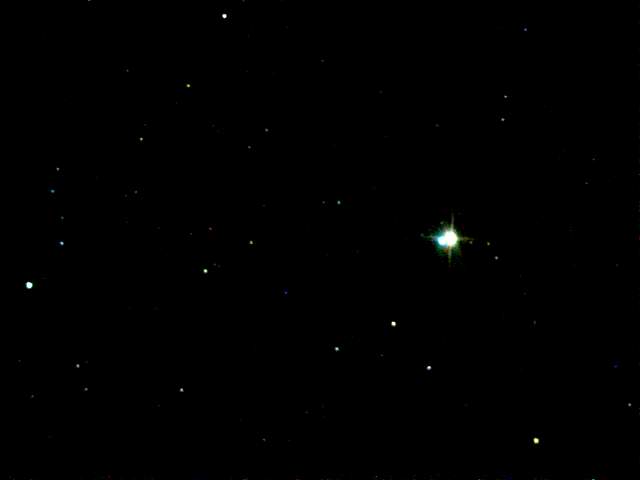
M-11: 10x8sec, histogram 0-32. 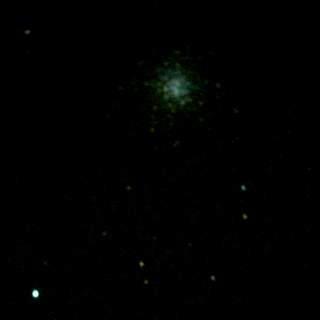
M-39: 10x8sec, histogram 0-64, mosaic of 4 images. 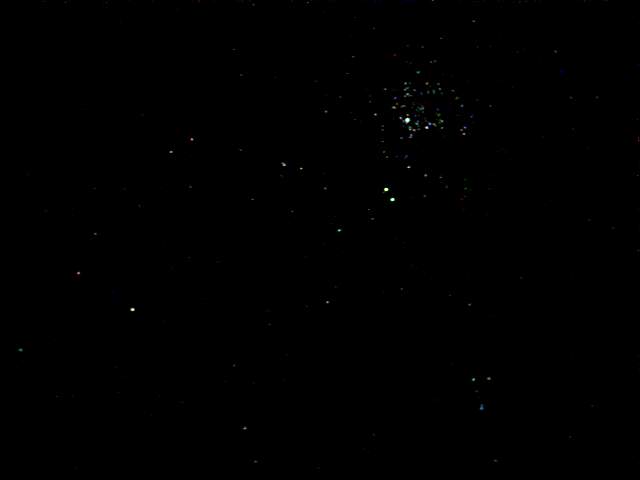
-John 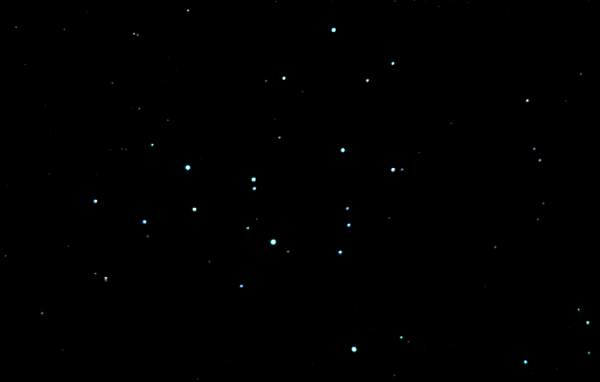
Subject: LPI pics Sent: Monday, July 5, 2004 07:49:23 From: Mr. Tom (MrTomsMail@gmx.net) Here are some LPI pics of the Venus transit on 8 June 2004.They were taken near Den Helder, Netherlands, 5258' North, 446' East with a 1000mm f/10 Maksutov ("Russentonne"), Baader sun foil and an orange filter. Exposure times were about 0,044 sec, adding about 30 frames for each picture. Please notice the 2 tiny sunspots also. I could not see any drop phenomena. Here are 2 LPI pics of M42 from 20 February 2004.
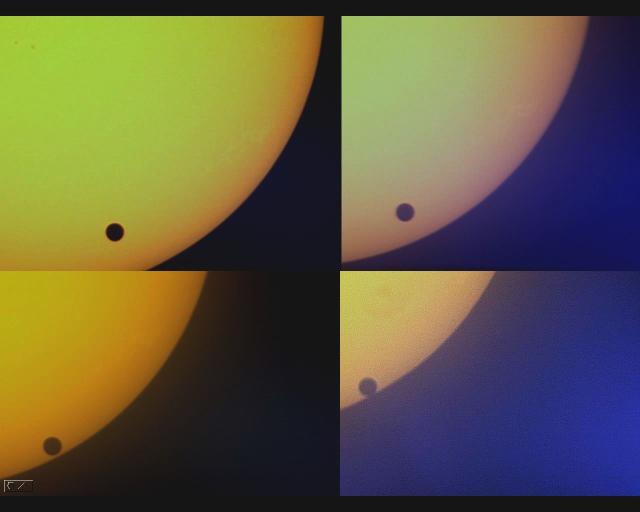
I added 20 frames, with an exposure of 16 seconds each. They were taken with my Celestron 9 1/4, focal reducer f/5 (an old 30 mm lens), colours and contrast were enhanced. The red picture is taken without, the blue one with OIII filter. Cheers, Tom, Aachen & Dortmund, Germany
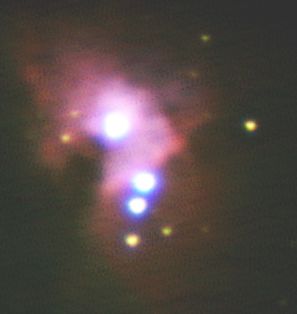
Subject: Meade LPI - Lunar Mosaics Sent: Friday, July 2, 2004 07:02:37 From: Graham, John L (Graham@udri.udayton.edu) Although the Meade LPI is only 640x480 it is a relatively simple matter to assemble several adjoining images into a mosaic to give a higher effective pixel count. Two examples of the Moon taken June 30th are attached. The first is a composite of two images taken at the prime focus of a StarBlast (4.5" f/4); each source image was an average of 25 frames with a minimum match quality of 50%. I used the LPI's auto exposure to set the base conditions, and then shortened the exposure a tad to keep the brightest features from washing out. No other adjustments were needed. This has proven to be an effective combination for getting full-disk images of the Moon with reasonable resolution.The second picture is a composite of four images taken at the prime focus of a Meade DS-2130 (5.1" f/8, the best $300 I've ever spent); each source image was an average of 10 frames with a minimum match quality of 50%. I again used the LPI's auto exposure to set the base conditions, shortened the exposure a tad to keep the brightest features from washing out, and then increased the gain to 70% to recover the terminator. This gave a gray background sky that I corrected in post processing. Note the subtle color on the lunar mare. 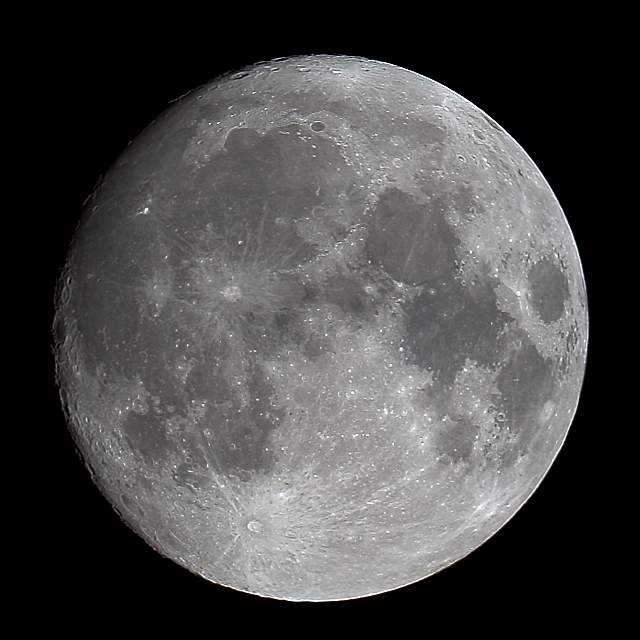
I attended Jack Newton's talk at the 2004 Apollo Rendezvous and he described this kind of photography as being akin to adaptive optics. The ability to capture and preserve those brief moments of clarity can produce amazing results with relatively simple equipment. The images with the LPI often show more detail than I can see visually, but once I notice something of interest in the pictures I can go back and take a closer look. It's been fun to experience how real-time imaging and image processing can enhance visual observing. Now that the Moon is leaving the evening sky I'll be turning my attention back to experimenting using the LPI for wide field and deep sky work. I'll keep better notes this time and let you know how things work out. Now if the weather will only cooperate... -John 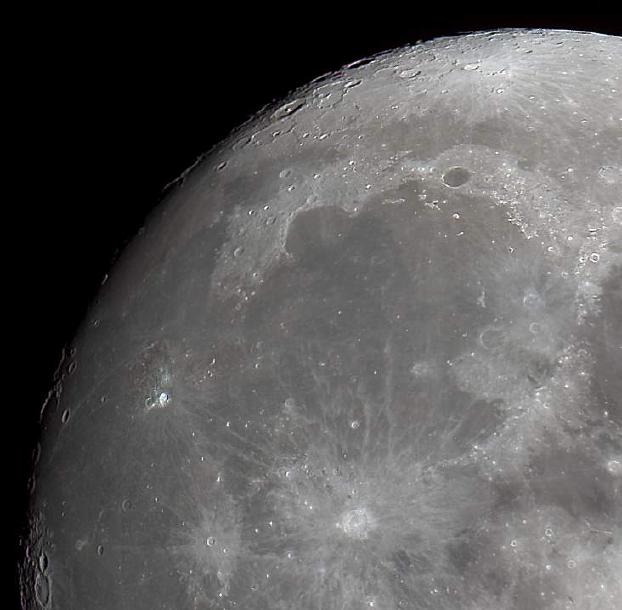
Return to the top of this page.
Go to the April-June 2004 LPI Page.
Go to the January-March 2004 LPI Page.
Go to the 2003 LPI Page.
Go back to the Astrophotography Page.
Go back to my ETX Home Page.